Effective leadership is at the heart of a high-performing, motivated team. Leaders play a crucial role in guiding, inspiring, and supporting their employees to achieve the company goals as well as their own aspirations. The Path Goal Theory of Leadership offers a valuable framework for understanding how leaders can fulfill this role effectively by complementing their subordinates by removing any challenges along the way.
In fact, a whopping 79% of employees report that the reason they quit their job was lack of appreciation by management. Imagine that you give it all to do your work tasks perfectly only to be taken for granted! Of course, there are many “connotations” in the causes of someone parting their ways with an employer because of lack of recognition, and they all lie in inadequate resources allocation and business process management.
At its core, the Path Goal Theory emphasizes the importance of aligning leadership behavior with the needs of the team and the demands of the situation. It identifies four primary types of leader behavior: directive, supportive, participative, and achievement-oriented. These behaviors are tailored to address the specific challenges and circumstances faced by the team.
In this article, we will explain what the Path Goal Theory of Leadership is and describe its four main manifestations. Also, we will suggest four ways to apply them in your organization.
What Is the Path Goal Theory of Leadership?

The Path Goal Theory of leadership, developed by Robert House in 1971, is a significant framework that aims to elucidate how leaders can motivate and guide their followers effectively to achieve organizational objectives. This theory suggests that leaders must clarify the path to goal attainment and provide the necessary support to assist their followers along that path.
Originating from the idea that effective leaders facilitate their followers’ journey towards success, the Path-Goal Theory has evolved over time, integrating insights from various psychological and organizational behavior studies. It emphasizes the dynamic relationship between leader behavior, follower characteristics, and situational factors in determining leadership effectiveness.
Central to the Path-Goal Theory are the four types of leader behavior: directive, supportive, participative, and achievement-oriented. Directive leadership involves providing clear instructions, expectations, and guidelines to followers. Supportive leadership focuses on creating a supportive and empathetic work environment, where leaders show concern for the well-being and personal needs of their followers. Participative leadership entails involving followers in decision-making processes, soliciting their input and feedback.
Achievement-oriented leadership involves setting challenging goals and demonstrating confidence in followers’ abilities to achieve them.
These leader behaviors are not mutually exclusive but can be combined and adapted based on situational factors. The effectiveness of each leadership style depends on various situational factors such as the nature of the task, the team’s experience and ability, and the work environment.
For instance, in a highly complex and ambiguous task, directive leadership may be more effective in providing clarity and guidance. In contrast, in a creative or innovative task, participative leadership may encourage followers to contribute diverse perspectives and ideas.
4 Types of Path Goal Leadership

Within the Path Goal Theory framework, leaders can adopt various leadership styles to effectively guide and motivate their teams toward achieving their goals. Each leadership style has unique characteristics and benefits that can influence team performance. Let’s explore the different types of Path Goal Leadership:
1.Directive Leadership
Directive leadership involves providing clear instructions, guidance, and expectations to team members. Leaders who adopt this style offer specific directives on how tasks should be accomplished, set clear goals, and establish procedures and deadlines.
The primary focus of directive leadership is to provide structure and clarity to team members, especially in situations where tasks are complex or team members lack experience. By providing clear guidance, directive leaders help employees understand their roles and responsibilities, reducing ambiguity and increasing confidence.
This style can be particularly effective in fast-paced environments where quick decisions are necessary and in situations where team members require explicit direction to achieve their objectives.
2.Supportive Leadership
Supportive leadership focuses on promoting the well-being, morale, and development of team members. Leaders who adopt this style demonstrate care and concern for their team members’ needs, provide emotional support, and foster a positive work environment.
This set of leaders actively listen to their team members, offer encouragement, and provide assistance when needed. They prioritize building strong relationships and trust within the team, which enhances collaboration and cohesion.
By promoting a supportive work environment, leaders can boost team morale, reduce stress, and increase job satisfaction. Additionally, supportive leadership encourages continuous learning and development, enabling team members to grow personally and professionally.
3.Participative Leadership
Participative leadership emphasizes involving team members in decision-making processes and problem-solving. Leaders who adopt this style seek input and feedback from their team members, encourage collaboration, and empower them to contribute ideas and solutions. Participative leaders value diversity of thought and perspective, leveraging the collective intelligence of the team to make informed decisions.
This leadership style fosters a sense of ownership and accountability among team members, as they feel invested in the decision-making process. By involving team members in decision-making, participative leaders can increase engagement, creativity, and commitment to achieving shared goals.
4.Achievement-Oriented Leadership
Achievement-oriented leadership focuses on setting challenging goals, promoting excellence, and driving performance. Leaders who adopt this style establish high standards of performance, communicate clear expectations, and provide feedback and recognition for achievements.
Achievement-oriented leaders inspire their team members to strive for excellence, encouraging them to surpass their previous achievements and reach their full potential. This leadership style cultivates a culture of continuous improvement and excellence within the team.
By setting ambitious goals and providing the necessary support and resources, achievement-oriented leaders motivate team members to perform at their best, driving results and success.
How to Implement the Path Goal Theory of Leadership at Work

Implementing the Path Goal Theory of Leadership in the workplace involves practical steps and strategies aimed at aligning leadership behavior with the needs of the team and the demands of the situation. Here are some tips for applying this theory effectively:
Conduct a Team Assessment
Start by conducting a thorough assessment of your team to understand their skills, experience, and motivation levels. Determine the most appropriate leadership style based on the team’s characteristics and the nature of the tasks they perform. Tailor your leadership approach to meet the specific needs and preferences of your team members.
Set Clear and Challenging Goals
Establish clear and challenging goals that align with the organization’s objectives and the team’s priorities. Clearly communicate expectations and provide direction on how team members can contribute to achieving these goals. Setting challenging yet achievable goals can inspire motivation, foster a sense of purpose, and drive performance.
Provide Regular Feedback and Support
Offer constructive feedback and support to your team members to help them progress toward their goals. Recognize and celebrate their achievements, while also providing guidance and assistance when needed. Regular feedback sessions provide opportunities for communication, learning, and growth, enhancing team performance and individual development.
Foster a Positive and Inclusive Team Culture
Create a positive and inclusive team culture where all team members feel valued, respected, and empowered to contribute. Encourage open communication, collaboration, and mutual support among team members. Foster a culture of trust, transparency, and accountability to promote teamwork and collaboration.
Wrapping Up
Effective leadership is pivotal in optimizing team performance. The Path Goal Theory highlights the importance of adapting leadership styles to meet the needs of teams and situations. Readers are encouraged to reflect on how they can apply this theory to their own leadership approach and work environment. By implementing the principles of the Path Goal Theory, leaders can foster motivation, collaboration, and success within their teams. Take action today to put these theories into practice and witness the positive impact on team performance firsthand.

